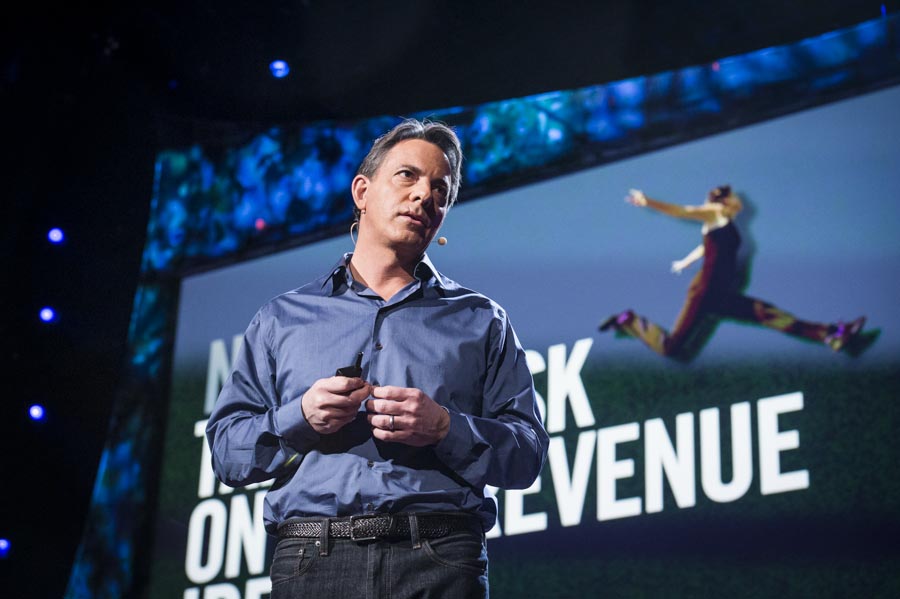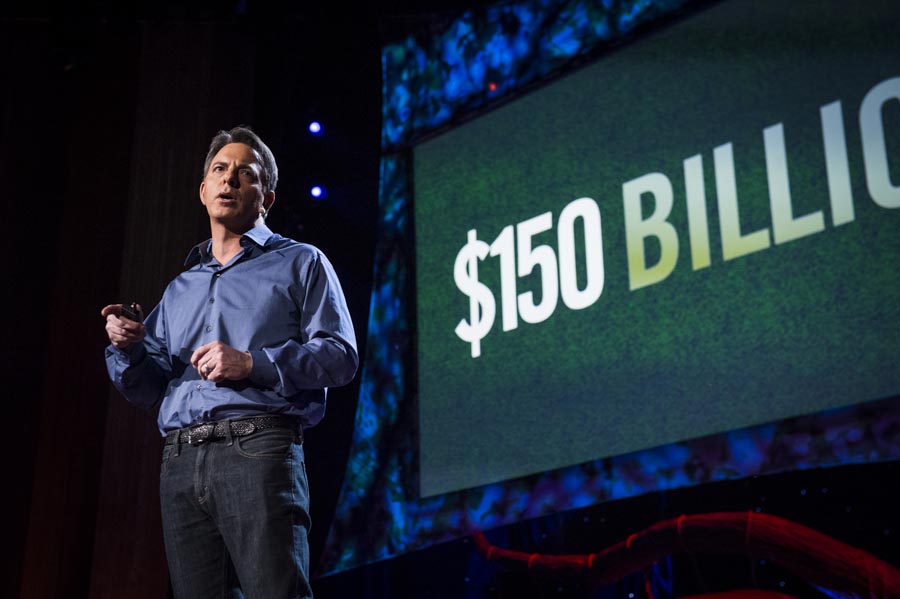Dan Pallotta created two huge charity initiatives — AIDS Rides bicycle journeys and Breast Cancer 3-Day events. These initiatives raised $108 million for HIV/AIDS and $194 million for breast cancer. Both had their best years in 2002 … and then Pallotta’s nonprofit went out of business.
In the final session of TED2013, Pallotta shares why that happened: Major sponsors pulled out following a slew of bad press over the idea that his organization was investing 40% of their gross into recruitment and customer service. The backlash came from our basic — and wrong — cultural understanding of charity.
“What we know about charity and the nonprofit sector is undermining the causes we believe in and our desire to change the world,” says Pallotta. We expect businesses and nonprofits to use “two separate rulebooks,” he suggests.
“Business will move the mass of humanity forward, but will always leave behind that 10% of the most disadvantaged and unlucky,” he says — which is why we need philanthropy and nonprofits. But couldn’t the nonprofit sector use the same strategies as the business world to grow their profits and give more money to the needy? After all, says Pallotta, “How do you monetize the prevention of violence against women?”
The nonprofit sector as we know it isn’t working. In the United States, poverty has been stuck at 12% for the last 40 years. Homelessness has not been solved in any major city, and we have no cure for cancer.
“Our social problems are gigantic in scale, our organizations are tiny up against them — and we have beliefs that keep them tiny,” says Pallotta, the president of Advertising for Humanity and author of Charity Case.
Pallotta outlines five ways in which nonprofits are handicapped in their mission to help people.
1. Compensation
“We have a visceral reaction to the idea of people making a lot of money helping others. Interestingly, we don’t have a visceral reaction to the idea that people should make a lot of money not helping other people,” says Pallotta. “It gives a stark, mutually exclusive choice between doing well for yourself and your family and doing well for world.”
For example, the average salary for a CEO of a hunger charity is $80K. Meanwhile the average salary for someone with an MBA, after ten years of school, is $400K.
“We send people marching from the nonprofit sector into the for-profit sector, because they’re not willing to make that kind of compromise,” says Pallotta. “Not a lot of people with $400K talent will make a $316K sacrifice every year.” And actually, it turns out it’s more financially advantageous for these talented business minds to take the big paycheck, give $100K to a hunger charity each year, reap the tax benefits and get the label of “philanthropist.”
2. Adveritsing and marketing
“We tell for-profits to spend, spend, spend on advertising,” says Pallotta, but nonprofits are expected not to advertise — unless the advertising space and airtime is donated. People want to see their money spent directly on the needy.
But Pallotta points out that money invested in advertising can be returned dramatically amplified. He uses his own initiatives as an example. Over nine years, more than 182,000 people participated in Pallotta’s AIDS Rides and Breast Cancer 3-Day events, raising a cummulative $581 million.
“We got that many people to participate because we bought full-page ads,” says Pallotta. “Do you know how many people we would have gotten if we advertised with fliers in the laundromat?”
Pallotta stresses that nonprofits need to be able to communicate with the public the incredible work that they are doing — and to ask for bold commitments in return. “People are yearning to be asked to use the full measure of their potential for somthing they care about,” he says.
3. Taking risks on new revenue ideas
Nonprofits are not allowed to try new things, says Pallotta, because public outcry sounds so quickly at a failure. As Pallotta found by using a different model of spending — experimentation is a big no-no for nonprofits.
“Nonprofits are reluctant to attempt any brave, daring new fundraising endeavors, because they’re scared their reputations will be dragged through the mud,” he says.
This fear kills innovation. And if nonprofits can’t try new things and grow — how can they possibly tackle problems of the size that our world has?
4. Time
On the same note, Pallotta points out that it took Amazon four years to turn a profit. While businesses are given time to build the infrastructure they need, non-profits are not afforded this luxury.
“If a non-profit had a dream of building at a magnificent scale, but it would require six years for the money to go to the needy, we would expect a crucifixion,” says Pallotta.
5. Profit to attract risk capital
This point is a simple one: nonprofits can’t go after capital, because they can’t be on the stock market. And how do you build scale without capital?
Pallotta stresses that the nonprofit sector is at an extreme disadvantage when compared with the for-profit sector. The difference is dramatic. Since 1970, 144 nonprofits have crossed the $50 million annual revenue barrier. In the same amount of the time, an astounding 46,136 for-profit businesses have surpassed that mark.
So how did this happen? Pallotta looks to American history for the answer. He shares how the Puritanical spirit saw self-interest as a ticket to hell. But charity was seen as the antidote, a way to do penance. “Financial interest was exiled from the realm of charity,” he says.
Today, Pallotta is horrified that only one question is used to evaluate a charity: What percentage of my donation goes to the cause versus overhead?
“It makes us think that overhead is a negative, that it is somehow not a part of ‘the cause,'” he says. “This forces organizations to forego what they need for growth.”
Pallotta shares how his organization used a more-business like model — taking $50K in initial funding for AIDS Rides and multiplying it to $108 million, and taking an $350K initial investment in Breast Cancer 3-Day walks and multiplying it to $194 million. Pallotta says that his organization could have gone the route of just giving the initial funding to research, but by investing in growth, they were able to give so much more.
“[And yet] 350 employees lost their jobs because they were labeled overhead,” says Palotta. “This is what happens when we confuse morality with frugality.”
Pallotta notes that charitable giving in the United States has remained stuck at 2% of the gross domestic product for the past four decades. What if, instead of requiring charities to tighten their belts, we let them grow and try to increase their marketshare?
Pallotta shows an interesting pie graph. Two percent of the US GDP equals $300 billion, with about $60 billion going to health and human services charities. But what if charitable giving could be boosted just 1%? That would be an extra $150 billion a year — just for health and human services charities.
“Our generation does not want its epithet to read, ‘We kept charity overhead low,'” concludes Pallotta. “We want it to read that we changed the world.”
And so next time you’re investigating at charity, he pleads: “Don’t ask about the size of their overhead — ask about the size of their dreams.”
Dan Pallotta’s talk is now available for viewing. Watch it on TED.com »


Comments (52)
Pingback: Una nueva forma de juzgar a las organizaciones sin fines de lucro – Dan Pallota en TED2013 | Dale la vuelta
Pingback: Gain all we can so that we can give all we can | chapterseventeendotcom
Pingback: TPF | Changing our understanding of philanthropy
Pingback: Bits & Pieces: Social Work Burnout & More - The Political Social Worker
Pingback: http://blog.ted.com/2013/03/01/a-new-way-to-judge-nonprofits-dan-pallotta-at-ted2013/ | flying kites
Pingback: What We’re Reading | Red Sky Public Relations
Pingback: My 13 favourite talks from TED 2013 | Sue Gardner's Blog
Pingback: The Chains on Charity «
Pingback: Dan Pallotta at TED | Sasha Dichter's Blog
Pingback: Open the Door | The Age of Impact